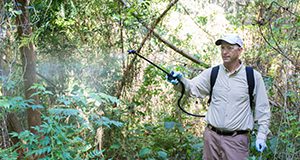Heat-related illness (HRI) can range from rashes, fainting, and cramps to heat exhaustion and heat stroke. It can be fatal, and all outdoor workers in agriculture (as well as those in high-heat indoor settings such as greenhouses) are at risk. This new 6-page publication of the UF/IFAS Department of Agricultural Education and Communication provides basic information on how to recognize the symptoms of HRI, on the underlying physiological processes and related risk factors, and on how to treat it. This publication also provides a list of preventative measures that growers, supervisors, and agricultural workers can follow, along with links to additional resources. Written by Paul Monaghan, Karissa Raskin, Maria Morera, Antonio Tovar, Valerie Mac, and Joan Flocks.
https://edis.ifas.ufl.edu/wc359
Tag: Agricultural Safety
Worker Protection Standard: Determining Your WPS Responsibilities
In 1992, the US Environmental Protection Agency (EPA) issued a comprehensive regulation called the Worker Protection Standard for Agricultural Pesticides (WPS). The EPA has made several changes to the WPS since it was fully implemented in 1995. This five-page document will address determining responsibilities under the revised WPS. Written by Frederick M. Fishel and published by UF’s Agronomy Department, September 2017.
http://edis.ifas.ufl.edu/ag418
There Is a Safety App for That! – Some Useful Agricultural Safety Apps
 An estimated 58 billion apps will be downloaded to smartphones and 14 billion to tablets in 2013. This 4-page fact sheet explores key features in smartphones and some available apps that can enhance the safety of agricultural operations. The apps presented represent a small fraction of the apps available on various platforms. Written by Michael T. Jensen, and published by the UF Department of Agricultural and Biological Engineering, August 2013.
An estimated 58 billion apps will be downloaded to smartphones and 14 billion to tablets in 2013. This 4-page fact sheet explores key features in smartphones and some available apps that can enhance the safety of agricultural operations. The apps presented represent a small fraction of the apps available on various platforms. Written by Michael T. Jensen, and published by the UF Department of Agricultural and Biological Engineering, August 2013.
http://edis.ifas.ufl.edu/ae498
ENY146/IN783 Living with African Bees in Florida’s Outdoor Workplaces
ENY-146, a 5-page illustrated fact sheet by M. K. O’Malley and J. D. Ellis, offers African honey bee related recommendations and precautions specific to outdoor workers in Florida. Includes references. Published by the UF Department of Entomology and Nematology, June 2008.
http://edis.ifas.ufl.edu/IN783

